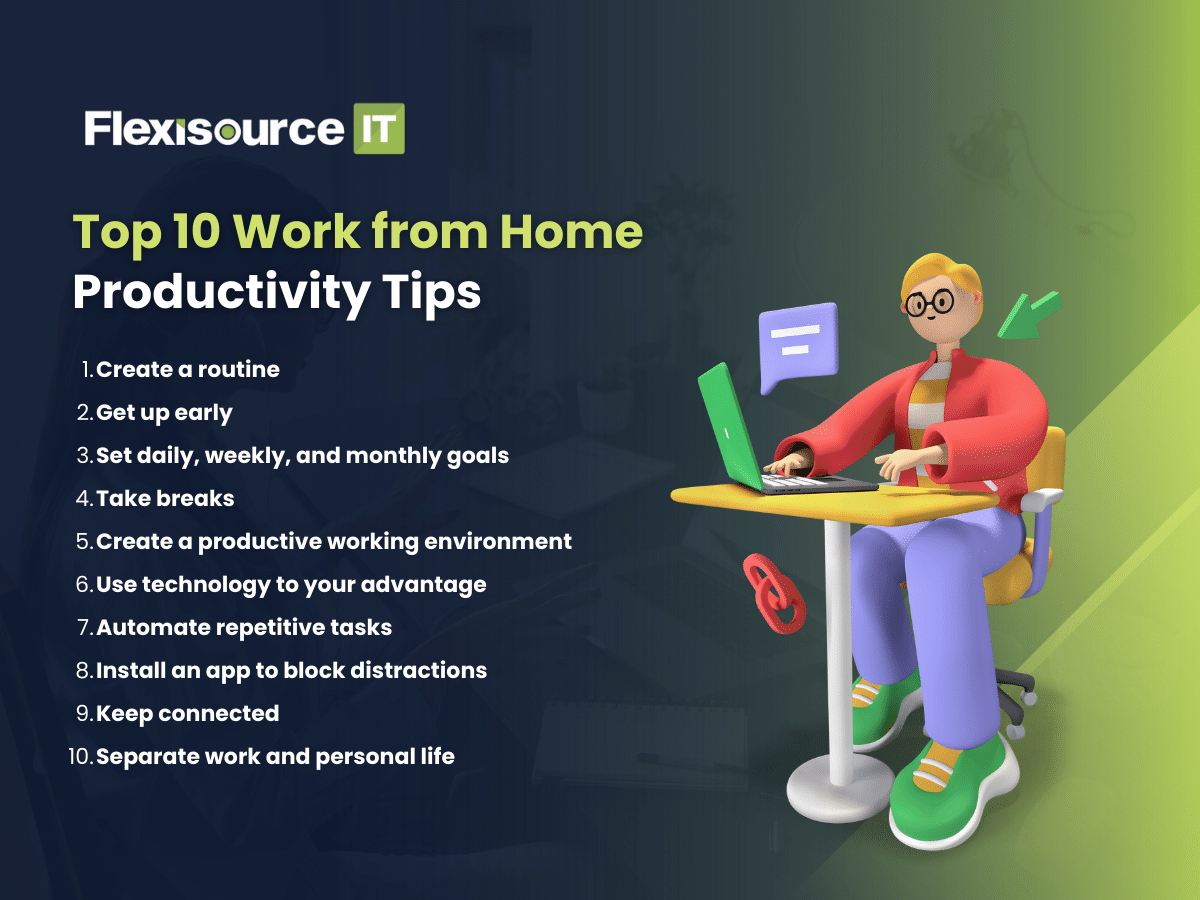Since its popularity, many companies have adopted remote working or working-from-home setups. However, only some people are fit for this kind of arrangement. Some may find their workday spiralling out of control when working from home. And before you know it, your productivity plummeted. So, how can you regain control of your productivity? In this article, we will tackle work-from-home productivity tips.
Table of Contents
What Is Productivity, and How Do You Measure It?
Productivity refers to the effectiveness of resources, such as time, labour, capital, and technology, in producing goods, services, or desired outcomes. It is a crucial concept in economics, business, and various fields, as it reflects how efficiently an individual, organisation, or economy can generate output from input. In a remote setting, remote working is the efficiency level of a contractor or individuals in producing the desired outcome while operating outside the traditional office environment.
Measuring productivity involves quantifying the relationship between inputs and outputs. However, it varies based on the environment and other elements. For a work-from-home setup, productivity can be measured differently. Here are some strategies and metrics you can consider when measuring productivity for employees working from home:
- Set specific, measurable, achievable, relevant, and time-bound (SMART) goals for remote employees. Regularly assess whether these goals are being met.
- Track the level of participation in virtual meetings, discussions, and collaboration platforms to gauge involvement in team activities.
- Monitor errors, mistakes, or rework in completed tasks to assess the quality of work produced.
- Collect feedback from colleagues, supervisors, or clients to evaluate the quality and effectiveness of remote work outputs.
- Assess how well remote employees adapt to changing circumstances, such as shifting priorities or unexpected challenges.
- Measure the generation of new ideas or innovative solutions contributing to the organisation’s success.
- Monitor remote employees’ engagement with their work and the organisation. Engaged employees are generally more productive and motivated.
- Measure the actual impact of remote work on the organisation’s goals, such as revenue growth, cost savings, customer satisfaction, etc.
Top 10 Work from Home Productivity Tips
Here are ten practical work from home productivity tips to help you stay focused, organised, and efficient in your remote work setup:

1. Create a routine
One of the must-have work from home productivity tips is routine. A well-structured routine establishes a predictable schedule, which helps remote workers know when they should be working, taking breaks, and finishing for the day. This consistency can help remote workers manage their tasks effectively, maintain focus, and achieve optimal results.
To create an effective routine when working from home, try the following:
- Outline your tasks for the day or week in advance.
- Define specific work hours and break times.
- Allocate time for high-priority tasks during your most productive periods.
- Regular breaks help maintain focus and prevent burnout.
- Designate specific times for checking emails and social media.
- Remain adaptable to unexpected changes.
- Periodically assess your routine’s effectiveness and adjust as needed.
2. Get up early
Getting up early when working from home offers several advantages that can positively impact your productivity, well-being, and work-life balance. First, it helps you establish a consistent start time, which sets the tone for the rest of your day. Second, many people often consider mornings the most productive part of the day. Your mind is fresh, and fewer distractions make it an ideal time to tackle important tasks.
Likewise, morning is also considered quieter and less chaotic. You will experience fewer interruptions from your family members and fewer notifications from co-workers. This can lead to better concentration and uninterrupted time to work on complex tasks that require attention.
Lastly, waking up early also help you to stay healthy while working from home. Waking up early helps regulate your sleep schedule and aligns with your body’s natural circadian rhythm. This consistency can improve the quality of your sleep, making you feel more rested and refreshed.
3. Set daily, weekly, and monthly goals
Setting goals while working from home is crucial for maintaining productivity and achieving success. When working remotely, it can be easy to lose focus and become distracted by the comforts of home. However, by setting clear and achievable goals, you can stay motivated and ensure you make the most of your time.
4. Take breaks
When working from home, employees tend to overwork themselves. This can lead to fatigue and poor decision-making. Taking a break is another crucial aspect of ensuring productivity when working from home.
Break provides a mental breather from work tasks, allowing your mind to reset and recharge. Remote workers can prevent mental fatigue and improve overall cognitive function through breaks. This helps them be more focused and productive throughout their day.
Here are some structure break and wellness tips for you:
- Frequent Short Breaks. Try to have short breaks every 1-2 hours. These breaks can be 5-10 minutes to stretch, hydrate, or step away from your workspace.
- Lunch Break. Take a proper lunch break away from your work area to eat, rest, and recharge. This break should be longer, around 30-60 minutes.
- Mindful Breaks. During your breaks, engage in activities that help you relax and shift your focus away from work. This could include meditation, deep breathing, or hobbies you enjoy.
- Physical Activity. Incorporate some form of physical activity into your breaks to keep your body active and combat the sedentary nature of remote work.
5. Create a productive working environment
The working environment influences your focus, productivity, and success. As such, one of the most important work from home productivity tips is having a productive workspace.
One key aspect of a productive working environment is having a dedicated workspace. Set up a designated area where you can focus solely on work, free from distractions. This could be a separate room or even just a specific corner of your living space. As much as possible, try to separate work from personal life.
Likewise, creating an effective home working environment also involves considering factors such as layout, furniture, and lighting. Try to invest in ergonomic furniture, proper lighting, and comfortable seating promotes physical comfort. This can prevent discomfort, strain, and health issues associated with poor posture.
Lastly, ensure it is well-organised and equipped with all the necessary tools to complete your job efficiently.
6. Use technology to your advantage
One of the essential work from home productivity tips is utilising technology. Technology plays a significant role in enhancing productivity and efficiency when working remotely. It can help employees automate tasks, manage their time effectively, and collaborate with their co-workers. Likewise, try the following tools when working from home:
- Productivity Apps. Utilise task management apps like Trello, Asana, or Todoist to organise and track your tasks and projects.
- Digital Calendars. Use digital calendar tools like Google Calendar or Microsoft Outlook to schedule tasks, meetings, and breaks. Set reminders to stay on track.
- Communication Tools. Use messaging and video conferencing tools like Slack, Microsoft Teams, or Zoom to stay connected with colleagues and clients. Schedule regular check-ins to maintain communication.
- Time Management Apps. Use time-tracking apps like Toggl or RescueTime to monitor your spending time and identify improvement areas.
- Automate Repetitive Tasks. Use automation tools like Zapier to connect different apps and automate routine tasks, saving time and effort.
- Health and Wellness Apps. Use apps like Fitbit, Apple Health, or MyFitnessPal to track physical activity, sleep, and overall health. These apps can remind you to take breaks and move.
7. Automate repetitive tasks
Being assiduous doesn’t necessarily mean working everything on your own. Sometimes, it should also mean working smart, like automating tasks with tools. Automation reduces the time spent on repetitive and manual tasks, freeing you to focus on more important and strategic work. Likewise, it also helps you accelerate workflows and reduce bottlenecks.
However, it’s important to remember that while automation can save time, you should still review and update your automated processes. Also, some tasks might still require a human touch, especially those involving personal interactions or complex decision-making. Striking the right balance between automation and human involvement maximises efficiency and maintains quality.
8. Install an app to block distractions
An app blocker can be a valuable tool for improving productivity by helping you manage and control your digital distractions. It allows you to block access to specific apps, websites, or social media platforms. By preventing access to distracting apps and websites, app blockers help you maintain a high level of focus on the task at hand. This improves concentration and task completion, making it a valuable work from home productivity tip.
However, striking a balance is essential when using an app blocker. While blocking distracting apps is beneficial, ensure that you allow access to tools and resources you genuinely need for work.
Also, remember that app blockers are a tool, not a complete solution. Combining them with good time management practices, effective task planning, and a well-structured work environment will yield the best results for productivity improvement.
9. Keep connected
Regular, transparent, and respectful communication is pivotal in maintaining a cohesive and productive work from home environment. It helps you align your tasks with the team’s objectives, preventing misunderstandings and ensuring your work contributes to the bigger picture.
So, try to utilise various communication tools, whether email, instant messaging, video conferencing, or project management platforms, to ensure everyone stays informed, engaged, and aligned with the team’s goals.
Likewise, managers must schedule virtual meetings and video conferences for discussions, brainstorming sessions, and team updates to foster face-to-face interactions. They should also set up informal virtual coffee breaks or “water cooler” chats where you can socialise and discuss non-work topics.
10. Separate work and personal life
Creating boundaries between work and personal life is an excellent work from home productivity tip. Sometimes, we may be overcome with compunction when working from home. It’s easy for lines to blur when your office is just steps away from your living room or bedroom. This can lead to burnout, stress, and unproductiveness.
As such, it’s essential to establish clear boundaries with family members or roommates, communicate your availability during work hours, and resist the temptation to constantly check emails or take on non-work-related tasks during designated work time.
Conclusion
In conclusion, remote work presents opportunities and challenges, and mastering it requires a blend of strategies, adaptability, and a proactive approach. By implementing the aforementioned practices and adapting them to your unique needs, you can thrive in the remote work environment and achieve productive professional life from the comfort of your home.
If you seek remote work prioritising this balance, consider exploring opportunities with Flexisource IT. We understand the importance of harmonising your career aspirations with your personal life. Join us and check our career page!
Pamela is a full-time content writer and a lifelong Philomath. Her previous experience as a research analyst made her passionate about traveling the world and understanding how it works. During her day off, you can often find her indoors, writing stories or oil painting.


